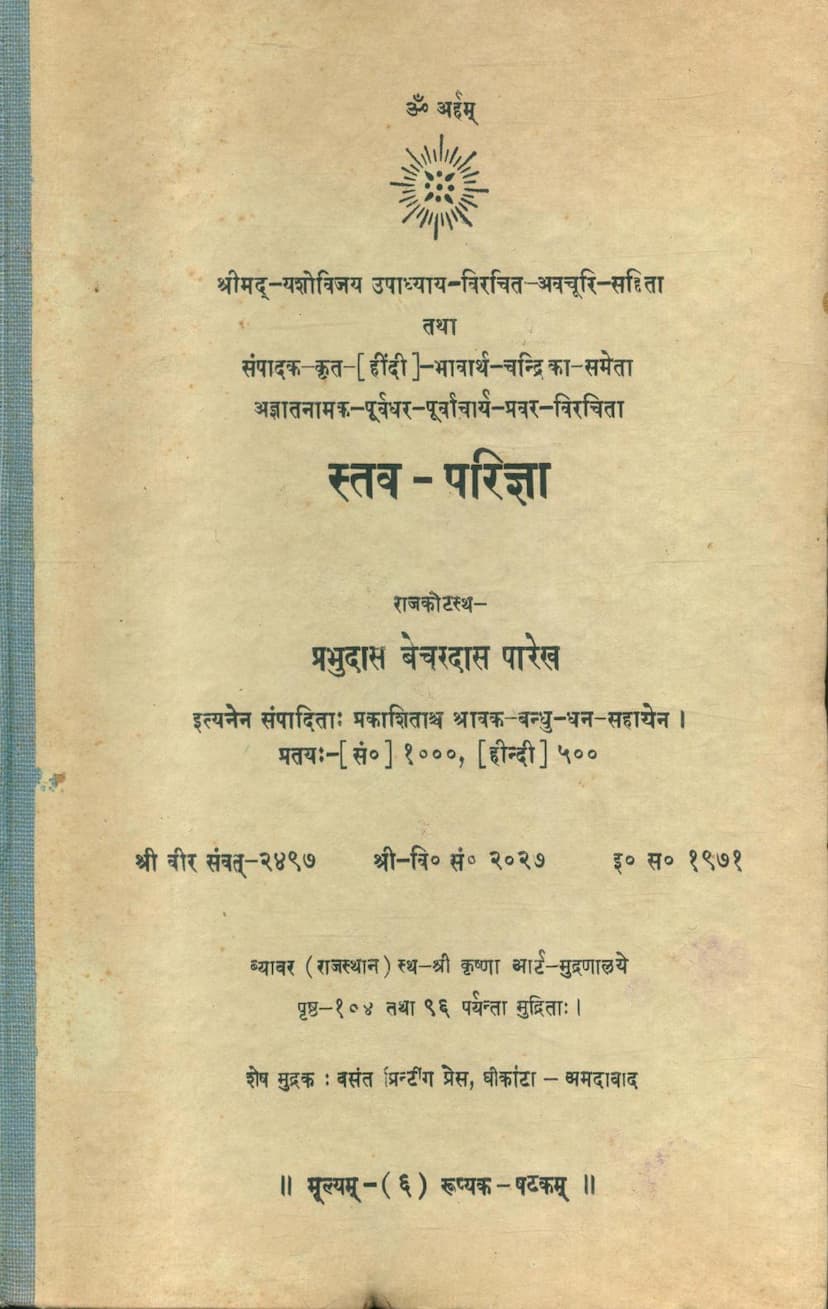Stav Parigna
Added to library: September 2, 2025

Summary
This is a comprehensive summary of the Jain text "Stav Parigna" by Prabhudas Bechardas Parekh, based on the provided pages.
Book Title: Stav Parigna (स्तव परिज्ञा) Author: Prabhudas Bechardas Parekh (compiled and published) Original Text Attribution: Unknown Pūrvadhar/Pūrvācārya, with commentary (Avacūrikā) by Shrimad Yashovijay Upādhyāya. Publisher: Shravak Bandhu Publication Year: Vira Samvat 2497 / Vikram Samvat 2027 / 1971 CE
Core Subject: The book "Stav Parigna" is a Jain scripture that primarily deals with the concept of "Stav" (praise or adoration) within the Jain philosophical framework. It aims to differentiate between two types of "Stav": Dravya Stav (द्रव्य स्तव) and Bhava Stav (भाव स्तव), and to explain their significance and proper practice.
Key Themes and Concepts:
-
The Nature of Stav: The text establishes that Stav has two main forms:
- Dravya Stav (Material/External Praise): This involves external actions and material offerings such as building temples (Jina Bhavana), installing idols (Jina Bimba), performing rituals, making offerings (like flowers, incense, food), singing, dancing, and giving donations. It is described as external and often associated with outward displays.
- Bhava Stav (Internal/Mental Praise): This refers to the internal state of mind, characterized by virtues like equanimity, restraint (Samyama), purity of conduct, spiritual discipline, and the cultivation of inner qualities. It is the pure, unwavering, and faultless practice of Jain principles.
-
The Preamacy of Bhava Stav: While acknowledging Dravya Stav, the text consistently emphasizes the superiority and ultimate goal of Bhava Stav. Dravya Stav is seen as a means or a preparatory step towards achieving Bhava Stav. External actions without the right inner disposition are considered incomplete or less effective.
-
The Purpose of Stav (Dravya Stav): Dravya Stav, when performed with the right intention and in accordance with Jain teachings (Aagams), serves several purposes:
- As a means to Bhava Stav: It helps cultivate devotion and inclination towards spiritual practices.
- To generate merit: It leads to good karma and pleasant rebirths.
- To inspire others: Well-executed Dravya Stav can inspire spiritual inclination in others.
- As a supportive action: It can be a catalyst for developing inner virtues.
-
The Proper Practice of Dravya Stav: The text outlines various guidelines for performing Dravya Stav appropriately:
- Purity of Materials: Materials used for building temples or rituals must be pure (Shuddha). This extends to the land, wood, and other substances used.
- Ethical Conduct with Workers: Those who work on building projects should be treated fairly and paid adequately. Their satisfaction is seen as contributing to the auspiciousness of the endeavor.
- Intention and Devotion: Even external acts should be performed with sincere devotion and a desire for spiritual progress, not merely for worldly gain.
- Following the Aagams: All practices must be in accordance with the Jain scriptures and the teachings of the Tirthankaras.
-
Differentiating True Sadhus: A significant portion of the text is dedicated to defining what constitutes a true Sadhu (monk). It uses the analogy of gold to explain how a Sadhu is to be tested:
- Qualities of Gold vs. Sadhu: Just as pure gold possesses certain inherent qualities (like not burning, retaining its luster, being a good conductor, etc.), a true Sadhu possesses specific virtues.
- Tests for a Sadhu: The text outlines several tests, often involving observing their conduct in various situations, their adherence to principles, their reactions to hardship, and their detachment from worldly desires. This includes observing their behavior in relation to "kashaya" (passions), "ched" (cutting/detachment), "tap" (penance), and "taadana" (endurance).
- The Importance of Aagmic Adherence: True Sadhu-hood is defined by strict adherence to the Aagams and the teachings of the Tirthankaras. Deviations, even if seemingly minor or driven by personal interpretation, are considered problematic.
-
Dravya Stav in Monastic Life: The text also discusses the role of Dravya Stav for monks. While their primary focus is Bhava Stav, they might engage in certain external acts like circumambulation (Pradakshina), bowing (Vandana), and rituals as expressions of devotion, but these are considered secondary and subservient to their inner state. The text emphasizes that monks do not engage in Dravya Stav for personal gain or outward show.
-
Critique of Vedic Practices: The book also includes a section that critically examines certain Vedic rituals, particularly those involving animal sacrifice (Yajna). It argues that such practices, which involve violence (Hinsa) for worldly benefit or even for perceived spiritual gain, are fundamentally flawed and contrary to the principles of Ahimsa (non-violence), which is central to Jainism. The text questions the logic of justifying violence for religious purposes, especially when it contradicts the core Jain tenet of Ahimsa.
-
The Role of Yatanā (Carefulness): The text highlights the importance of Yatanā (carefulness and diligence) in all actions, especially in religious practices. Yatanā is considered essential for minimizing harm (Hinsa) and for purifying one's spiritual progress. Even seemingly harmful actions, when performed with extreme Yatanā and for a higher spiritual purpose, are viewed differently.
-
Influence of Context and Intention: The text suggests that the nature of an action (whether it leads to merit or demerit) is significantly influenced by the intention behind it and the context in which it is performed.
Structure and Commentary: The book presents the original scripture in verses (Gathas), followed by a detailed commentary (Avacūrikā) by Yashovijay Upādhyāya and a Hindi explanation (Bhāvārtha Candrikā) by Prabhudas Bechardas Parekh. The summary and explanation aim to make the complex philosophical concepts accessible to readers.
Overall Message: "Stav Parigna" is a profound exploration of devotion and spiritual practice in Jainism. It guides practitioners to understand the true essence of praise and worship, emphasizing that while external actions have their place, the ultimate spiritual realization lies in the cultivation of inner purity, virtuous conduct, and unwavering adherence to the principles of Jainism, all guided by the wisdom of the Aagams and the Tirthankaras. The critique of Vedic practices underscores Jainism's unique commitment to Ahimsa as the supreme virtue.